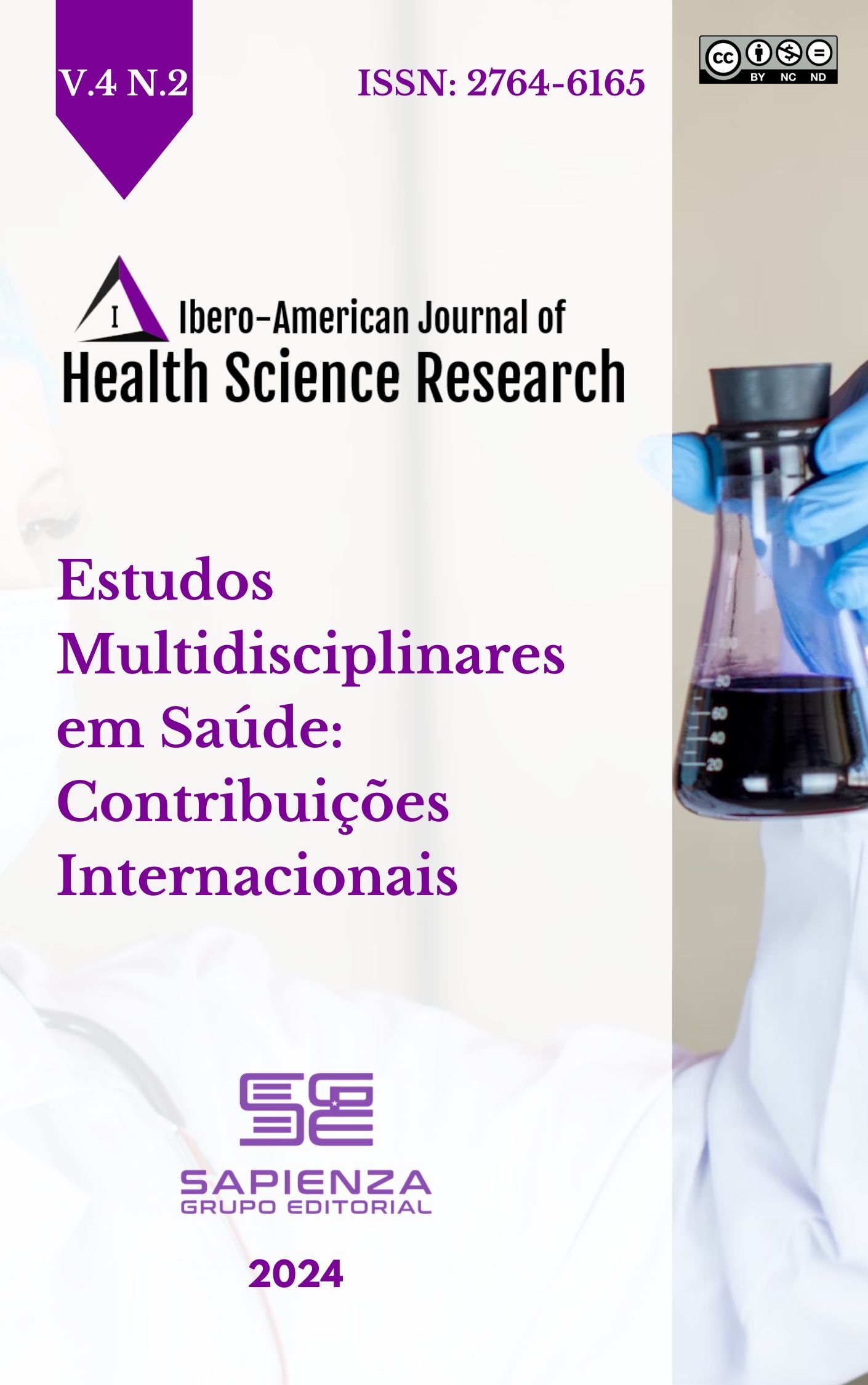Exercise program based on the pilates method for muscle flexibility in poultry workers
DOI:
https://doi.org/10.56183/iberojhr.v4i2.690Palavras-chave:
Musculoskeletal Pain; Exercise; Absenteeism; Poultry.Resumo
Background: Musculoskeletal (MS) disorders in poultry workers range from mild ailments to severe pain and illness; caused by lack of flexibility. Pilates exercises have positive effects on physical condition. Objective: Apply a Pilates-based exercise program to improve muscle flexibility in poultry workers. Methods: A study was developed in 29 workers who met the inclusion criteria. The intensity of pain was assessed with the visual analog scale and the level of flexibility with the Flexitest, to determine the needs of the workers and design the program based on Pilates. The program was validated by expert judgment and applied for 12 weeks, pain intensity and flexibility level were reassessed. Results: They demonstrated significant clinical and statistical improvements in the entire population, decreasing the intensity of pain from moderate and severe to mild (p<0.005) and improving flexibility from levels 1 and 2, which are poor and medium, to level 3, which is good flexibility. (p<0.005) after the program. Conclusion: The Pilates-based exercise program improves muscle flexibility and decreases pain intensity in poultry workers.
Referências
Armando, J., Claros, V., Hernán, F., & Grajales, V. (2020). Flexibilidad de miembros inferiores y fuerza abdominal en futbolistas juveniles mediante aplicación del método Pilates. Revista Investigaciones Andina, 22(41). https://doi.org/10.33132/01248146.1776
Caicedo-Molina, I., Barbosa-Peña, M., Cruz-Cruz, W., Gualtero-Ussa, H., & Sanabria-Chacón, J. (2013). Fuerza muscular, flexibilidad y postura en la prevalencia de dolor lumbar de los tripulantes de helicópteros del Ejército Nacional de Colombia. Revista de La Facultad de Medicina, 61(4), 357–363. http://www.scielo.org.co/scielo.php?script=sci_arttext&pid=S0120-00112013000400004&lng=en&nrm=iso&tlng=es
Caieiro, T. T. M., De Assis, D. B., Mininel, V. A., Rocha, F. L. R., & Hortense, P. (2019). Musculoskeletal pain: comparison between administrative and production employees of a poultry farming company. Revista Brasileira de Medicina Do Trabalho, 17(1), 30. https://doi.org/10.5327/Z1679443520190277
César, O., & Klever, G. (n.d.). Negotium 5/12 Active breaks in public and private companies of the ecuadorian legal system pausas activas en las empresas públicas y privadas del ordenamiento jurídico ecuatoriano. www.revistanegotium.org.ve/núm.44
Cieza, A., Causey, K., Kamenov, K., Hanson, S. W., Chatterji, S., & Vos, T. (2020). Global estimates of the need for rehabilitation based on the Global Burden of Disease study 2019: a systematic analysis for the Global Burden of Disease Study 2019. The Lancet, 396(10267), 2006–2017. https://doi.org/10.1016/S0140-6736(20)32340-0
Cristóbal, R. V., Miñarro, P. A. L., Cárceles, F. A., & Ros, F. E. (2015). The effects of the pilates method on hamstring extensibility, pelvic tilt and trunk flexion]. Nutricion Hospitalaria, 32(5), 1967–1986. https://doi.org/10.3305/NH.2015.32.5.9678
De Oliveira, N. T. B., Ricci, N. A., Dos Santos Franco, Y. R., Salvador, E. M. E. S., Almeida, I. C. B., & Cabral, C. M. N. (2019). Effectiveness of the Pilates method versus aerobic exercises in the treatment of older adults with chronic low back pain: a randomized controlled trial protocol. BMC Musculoskeletal Disorders, 20(1). https://doi.org/10.1186/S12891-019-2642-9
Gholamalishahi, S., Backhaus, I., Cilindro, C., Masala, D., & La Torre, G. (2022). Pilates-based exercise in the reduction of the low back pain: an overview of reviews. European Review for Medical and Pharmacological Sciences, 26(13), 4557–4563. https://doi.org/10.26355/EURREV_202207_29176
INEC, Indicadores económicos-Censo de Población y Vivienda 2010. (n.d.).
Instituto Nacional de Medicina y Seguridad en el Trabajo (Spain), M. L., Vázquez Ubago, M., Paredes Rizo, M. L., & Vázquez Ubago, M. (2018). Medicina y seguridad del trabajo. In Medicina y Seguridad del Trabajo (Vol. 64, Issue 251). Instituto Nacional de Medicina y Seguridad del Trabajo. https://scielo.isciii.es/scielo.php?script=sci_arttext&pid=S0465-546X2018000200161&lng=es&nrm=iso&tlng=es
Isacowitz, Rael. (2016). Manual completo del método Pilates (2a. ed.). 881. https://www.google.com.ec/books/edition/Manual_completo_del_m%C3%A9todo_pilates/gmTDDwAAQBAJ?hl=es&gbpv=0
Josiane, A.; Cruz, C., Liberali, R., Fonseca Da Cruz, M., Ines, M., & Netto, A. (2016). The Pilates method in the rehabilitation of musculoskeletal disorders: a systematic review. Fisioterapia Em Movimento, 29(3), 609–622. https://doi.org/10.1590/1980-5918.029.003.AO19
Kao, Y. H., Liou, T. H., Huang, Y. C., Tsai, Y. W., & Wang, K. M. (2015). Effects of a 12-week Pilates course on lower limb muscle strength and trunk flexibility in women living in the community. Health Care for Women International, 36(3), 303–319. https://doi.org/10.1080/07399332.2014.900062
Kersten, P., White, P. J., & Tennant, A. (2014). Is the Pain Visual Analogue Scale Linear and Responsive to Change? An Exploration Using Rasch Analysis. PLoS ONE, 9(6), 99485. https://doi.org/10.1371/journal.pone.0099485
Madriz-Quirós, C. E., & Sánchez-Brenes, O. (2021). Ergonomic factors of risk for agricultural workers in the northern area of Cartago, Costa Rica. Tecnología En Marcha, 34, 127–142. https://doi.org/10.18845/tm.v34i1.4575
Manuel, M., Mesa, L., María, E., & González, R. (2023). Pilates. Efectos en la función física y sus limitaciones. Revisión sistemática y metaanálisis (Pilates Effects on physical function and its limitations. Systematic review and metaanalysis). Retos, 47, 188–200. https://doi.org/10.47197/RETOS.V47.92937
OIT. (2019, April 18). SEGURIDAD Y SALUD EN EL CENTRO DEL FUTURO DEL TRABAJO. https://www.ilo.org/wcmsp5/groups/public/---dgreports/---dcomm/documents/publication/wcms_686762.pdf
Oliveira, L. C. de, Oliveira, R. G. de, & Pires-Oliveira, D. A. de A. (2016). Comparison between static stretching and the Pilates method on the flexibility of older women. Journal of Bodywork and Movement Therapies, 20(4), 800–806. https://doi.org/10.1016/J.JBMT.2016.01.008
Renkawitz, T., Boluki, D., & Grifka, J. (2006). The association of low back pain, neuromuscular imbalance, and trunk extension strength in athletes. The Spine Journal: Official Journal of the North American Spine Society, 6(6), 673–683. https://doi.org/10.1016/J.SPINEE.2006.03.012
Sahiner-Picak, G., & Yesilyaprak, S. S. (2022). Effects of clinical pilates exercises in patients with chronic nonspecific neck pain: a randomized clinical trial. Irish Journal of Medical Science. https://doi.org/10.1007/S11845-022-03101-Y
Santos, M.; Machado, E.; Caeano, C.; Souza, C.; Freitas, L.; Fernandes, B. (2021, December 28). Eficacia del método pilates en el tratamiento del dolor lumbar inespecífico: un ensayo controlado aleatorizado. Fisioterapia Mundial. https://world.physio/es/congress-proceeding/effectiveness-pilates-method-treatment-nonspecific-low-back-pain-randomized
Soares De Araújo, C. G. (2005). FLEXITEST Un método innovador de evaluación de la flexibilidad. http://www.paidotribo.com
Sociedad, U. Y., Díaz, O., Maldonado, C., Ramos, H., Chacha, G., Vizuete, C., Los Trabajadores El Mejoramiento Del, D. Y., Eduardo Ochoa Díaz, C., Alejandro Centeno Maldonado, P., Luciano Hernández Ramos, E., Aníbal Guamán Chacha, K., & Rosario Castillo Vizuete, J. (2020). La seguridad y salud ocupacional de los trabajadores y el mejoramiento del medio ambiente laboral referente a las pausas activas. Revista Universidad y Sociedad, 12(5), 308–313. http://scielo.sld.cu/scielo.php?script=sci_arttext&pid=S2218-36202020000500308&lng=es&nrm=iso&tlng=es
Soto-Rodríguez, F., Muñoz- Poblete, C., (2018). Percepción del Beneficio del Ejercicio para la Prevención de Trastornos Musculoesqueléticos. Una Perspectiva del Trabajador. Ciencia & Trabajo, 20(61), 14–18. https://doi.org/10.4067/S0718-24492018000100014
Tejada-Medina, V., Caro, C. D., García, C. G., & Ruiz-Montero, P. J. (2021). Physical intervention programs in older women trought pilates method: A systematic review. Retos, 39, 19–29. https://doi.org/10.47197/RETOS.V0I39.78005
Puente, V., & Herrera, J. (2022). Vista de Propuesta de estrategias de prevención de enfermedades musculoesqueléticas en agricultores. Sapienza, 3(2675–9780). https://doi.org/doi.org/10.51798/sijis.v3i5.440
Valldaura, I. (2007). Método Pilates. Farmacia Profesional, 21(4), 42. https://www.elsevier.es/es-revista-farmacia-profesional-3-articulo-metodo-pilates-13102031
Vicente-Herrero, M. T., López-González, Á. A., Ramírez-Iñiguez de la Torre, M. V., Capdevila-García, L. M., Terradillos-García, M. J., & Aguilar Jiménez, E. (2015). Dolor en trabajadores: prevalencia e intensidad. Repercusión de variables sociodemográficas y laborales. Rev. Asoc. Esp. Espec. Med. Trab, 158–169. http://scielo.isciii.es/scielo.php?script=sci_arttext&pid=S1132-62552015000400003&lng=es&nrm=iso&tlng=es
Zamora-Macorra, M., Martínez-Alcántara, S., & Balderas-López, M. (2019). Trastornos musculoesqueléticos en trabajadores de la manufactura de neumáticos, análisis del proceso de trabajo y riesgo de la actividad. Acta Universitaria, 29, 1–16. https://doi.org/10.15174/AU.2019.1913
Downloads
Publicado
Como Citar
Edição
Seção
Licença
Copyright (c) 2024 Alex Omar Pérez Cunalata, Paola Gabriela Ortiz Villalba, Gerardo Fernando Fernández Soto, María Alexandra Vaca Sánchez

Este trabalho está licenciado sob uma licença Creative Commons Attribution-NonCommercial-NoDerivatives 4.0 International License.



